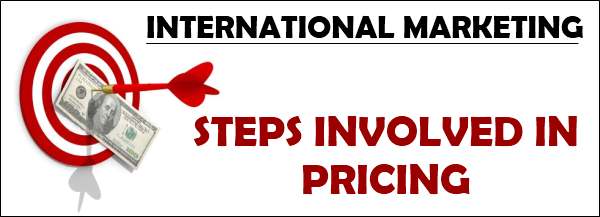Pricing in International Marketing | Steps Involved
Steps involved in Pricing in International Marketing
The task of determining prices in international marketing is a complex one. Particularly, it is complicated by fluctuating exchange rates which may bear only limited relationship to underlying cost. So, global marketers should follow appropriate steps to determine export price. The steps involved in pricing are
- defining pricing objectives
- analyzing market characteristics
- Calculating costs
- Calculating values of incentives; and
- determining export price.

1. Determining pricing objectives: Pricing is a means to achieve certain marketing objectives. An overall goal should aim at contributing to the company’s sales and profit objectives. However, the other pricing objectives may include market penetration, market skimming, market share, preventing entry of competitors, early recoupment of investment, profit maximization, etc.
Generally, consumers do not object to price. Pricing may be based on any objective depending upon the conditions of the marketer. But what they actually object to is the inconsistent relationship between the price charged for the product and its perceived value.
2. Analyzing market characteristics: The firm’s pricing objective must be consistent with the nature and characteristics of markets. The characteristics, competitive conditions and the paying capacity of different markets differ from each other.
The international marketer should study the market to determine the prices to be charged. He should find out what the market can afford to pay. The upper limit is set by what the market can afford to pay, The marketer should consider other factors related to the price. The margins of various middlemen, import duty, internal taxes, insurance cost and transport cost, etc., should also be covered by the price.
3. Calculating cost: A careful analysis of cost is necessary for determining export prices. There is a variety of costs to exports. Direct production costs include material, labor and other expenses required to manufacture the goods. Materials, labor and the expenses which are indirectly involved in producing the goods constitute production overheads. Market and distribution costs are incurred for getting orders, handling orders, packing the goods and sending them to customers.
Apart from these routine costs, special packaging and handling, credit and collection, documentation for export transactions involve costs. Those costs which are directly incurred for export purposes should necessarily be realized from the price.
4. Estimating the value of incentives: The value of incentives available to the exporter should be deducted from the total cost incurred for the export order. An exporter can claim several incentives in the form of duty drawback, cash compensatory support, replenishment license or exim scrip, premium on the foreign exchange and income tax benefits. These incentives reduce the cost of exporter.
5. Determining export price: The costs as enumerated above give the lower limit for export pricing. The estimates of the cost should be compared against the market price. Then the company should determine whether export at the estimated market price is feasible. The excess of market price over total costs gives profit to the exporter.

